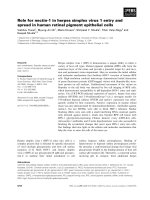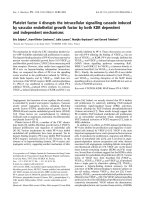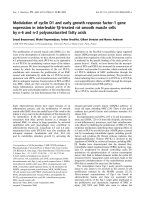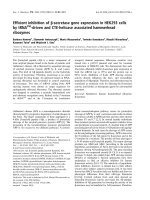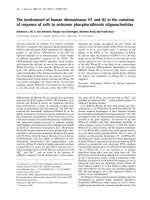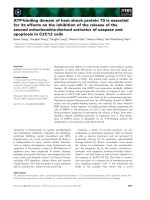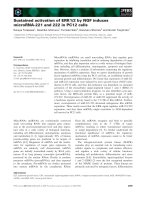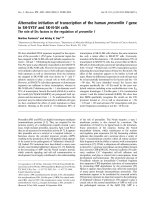ENDOTHELIAL COLONY FORMING CELLS (ECFCS): IDENTIFICATION, SPECIFICATION AND MODULATION IN CARDIOVASCULAR DISEASES
Bạn đang xem bản rút gọn của tài liệu. Xem và tải ngay bản đầy đủ của tài liệu tại đây (3.11 MB, 144 trang )
Graduate School ETD Form 9
(Revised 12/07)
PURDUE UNIVERSITY
GRADUATE SCHOOL
Thesis/Dissertation Acceptance
This is to certify that the thesis/dissertation prepared
By
Entitled
For the degree of
Is approved by the final examining committee:
Chair
To the best of my knowledge and as understood by the student in the Research Integrity and
Copyright Disclaimer (Graduate School Form 20), this thesis/dissertation adheres to the provisions of
Purdue University’s “Policy on Integrity in Research” and the use of copyrighted material.
Approved by Major Professor(s): ____________________________________
____________________________________
Approved by:
Head of the Graduate Program Date
Samantha L. Deitz
MOLECULAR BASIS AND MODIFICATION OF A NEURAL CREST DEFICIT IN A DOWN
SYNDROME MOUSE MODEL
Master of Science
Randall J. Roper
Ellen A.G. Chernoff
Hua-Chen Chang
Randall J. Roper
Simon Atkinson
05/03/2012
Graduate School Form 20
(Revised 9/10)
PURDUE UNIVERSITY
GRADUATE SCHOOL
Research Integrity and Copyright Disclaimer
Title of Thesis/Dissertation:
For the degree of
Choose your degree
I certify that in the preparation of this thesis, I have observed the provisions of Purdue University
Executive Memorandum No. C-22, September 6, 1991, Policy on Integrity in Research.*
Further, I certify that this work is free of plagiarism and all materials appearing in this
thesis/dissertation have been properly quoted and attributed.
I certify that all copyrighted material incorporated into this thesis/dissertation is in compliance with the
United States’ copyright law and that I have received written permission from the copyright owners for
my use of their work, which is beyond the scope of the law. I agree to indemnify and save harmless
Purdue University from any and all claims that may be asserted or that may arise from any copyright
violation.
______________________________________
Printed Name and Signature of Candidate
______________________________________
Date (month/day/year)
*Located at />MOLECULAR BASIS AND MODIFICATION OF A NEURAL CREST DEFICIT IN A DOWN
SYNDROME MOUSE MODEL
Master of Science
Samantha L. Deitz
05/03/2012
MOLECULAR BASIS AND MODIFICATION OF A NEURAL CREST DEFICIT IN A DOWN
SYNDROME MOUSE MODEL
A Thesis
Submitted to the Faculty
of
Purdue University
by
Samantha L. Deitz
In Partial Fulfillment of the
Requirements for the Degree
of
Master of Science
August 2012
Purdue University
Indianapolis, Indiana
ii
ii
For my friends and family for their support, encouragement, and challenges to my way
of thinking. Your advice and questions have been priceless.
iii
iii
ACKNOWLEDGEMENTS
I would like to thank my mentor, Dr. Randall Roper, for his perseverance with me
through troubleshooting protocols, his undying persistence, and the many lab and life
skills he has instilled in me through my six years in his laboratory. He has not only
molded me into an inquisitive scientist with a healthy level of skepticism, but also into
an individual who does not accept no for an answer. I would like to thank my committee
members, Dr. Ellen Chernoff and Dr. Hua-Chen Chang, for their valuable feedback and
guidance through the thesis writing process. Lastly, I would like to thank the many
Roper Lab members I have had the privilege of getting to know over my time in the
laboratory for their support, encouragement, and friendship.
iv
iv
TABLE OF CONTENTS
Page
LIST OF TABLES vi
LIST OF FIGURES vii
ABSTRACT ix
CHAPTER 1. INTRODUCTION 1
1.1 Down Syndrome 1
1.2 Human Genotype-Phenotype Relationships 6
1.3 Mouse Models of Down Syndrome 9
1.4 Mouse Genotype-Phenotype Relationships 15
1.5 Dyrk1a: a Candidate Gene for Craniofacial Development Regulation 17
1.6 Craniofacial Development 20
1.7 Cellular Phenotypes of Down Syndrome 23
1.8 Treatments in Down Syndrome 25
1.9 Inhibitors of Dyrk1a as Treatment in Down Syndrome 28
1.10 Hypotheses 31
CHAPTER 2. MATERIALS AND METHODS 32
2.1 Mouse Husbandry 32
2.2 Mouse and Embryo Genotyping 33
2.3 RNA Isolation 36
2.4 Cell Culture 37
2.4.1 Proliferation Assay 38
2.4.2 Migration Assay 40
2.5 Quantitative (q)PCR 41
2.6 In vivo Assessment of the Effects of EGCG 42
2.6.1 Treatment Technique 42
2.6.2 Embryo Processing 42
2.6.3 Histology …… 43
2.6.4 Stereological Analysis 44
CHAPTER 3. RESULTS: GENETIC DYSREGULATION AND MODIFICATION IN VITRO 46
3.1 Dyrk1a and Rcan1 Are Dysregulated in the Ts65Dn E9.25 and
E9.5 PA1 and NT 46
3.2 Dyrk1a and Rcan1 Are Dysregulated in the Ts1Rhr E9.5 PA1 47
v
v
Page
3.3 Ts65Dn Embryo PA1 and NT Display Proliferation and Migration
Deficits In Vitro 47
3.4 Ts1Rhr Embryos Do Not Display Proliferation or Migration
Deficits In Vitro 49
3.5 EGCG Ameliorates Ts65Dn Embryo Proliferation and Migration
Deficits In Vitro 49
3.6 EGCG Does Not Alter Ts1Rhr Embryo Proliferation or Migration
In Vitro 50
3.7 Harmine Ameliorates Ts65Dn Embryo Proliferation Deficits
In Vitro 52
3.8 Harmine Does Not Alter Ts1Rhr E9.5 Embryo PA1 Proliferation
In Vitro 52
CHAPTER 4. RESULTS: THE EFFECTS OF EGCG IN VIVO 54
4.1 In Vivo EGCG Treatment Does Not Affect Litter Size 54
4.2 In Vivo EGCG Treatment Does Alter Embryonic Developmental
Stage at E9.5 54
4.3 EGCG Increases PA1 Cell Number in Trisomic and Euploid Embryos
In Vivo 55
4.4 EGCG Increases PA1 ande Embryo Volume In Vivo 55
4.5 EGCG Alters Expression of Genes in Pathways Implicated in
Craniofacial Development In Vivo 56
CHAPTER 5. DISCUSSION 57
5.1 Dysregulation of Dyrk1a and Rcan1 E9.5 May Lead to Altered
NFAT Activity and Bone Development 57
5.2 Gene Dysregulation is Temporally Altered through Midgestation
in the PA1 59
5.3 EGCG and Harmine Ameliorate Proliferation and Migration Deficits
in Ts65Dn PA1 and NT Tissues In Vitro 60
5.4 EGCG and Harmine Ater Proliferation and Migration in Ts1Rhr PA1
and NT Tissues In Vitro 61
5.5 EGCG Does Not Negatively Impact Embryonic Development
In Vivo 62
5.6 EGCG Ameliorates the PA1 Cell Deficit at E9.5 and May be
Therapeutic for other DS Phenotypes 64
5.7 EGCG Alters Expression of Genes Implicated in Craniofacial
Development Pathways 66
5.8 Future Studies 67
LIST OF REFERENCES 69
TABLES 83
FIGURES 85
PUBLICATION 118
vi
vi
LIST OF TABLES
Table Page
Table 1.1 Higher prevalence of DS births to advanced age women 83
vii
vii
LIST OF FIGURES
Figure Page
Figure 1.1 Mosaicism may result from genetically normal or trisomic zygote due
to mitotic errors 85
Figure 1.2 Susceptibility regions for various phenotypes have been developed
from phenotypic mapping 86
Figure 1.3 Mice display a high level of homology with humans in craniofacial
bones 87
Figure 1.4 Hsa 21 genes can be found on Mmu 10, 16, and 17 with differing
contributions of genes from each Mmu chromosome 88
Figure 1.5 Mouse models of Down syndrome 89
Figure 1.6 DYRK1A and RCAN1 are involved in multiple biological processes and
pathways 90
Figure 1.7 Regulation of NFAT localizaiton by DYRK1A and RCAN1 91
Figure 1.8 Natural and synthetic DYRK1A inhibitors 92
Figure 2.1 The use of fluorescence in situ hybridization (FISH) to genotype
Ts65Dn mice and embryos 93
Figure 2.2 Utilization of the scratch test for quantification of migration 94
Figure 2.3 A plate schematic for qPCR analysis of RNA 95
Figure 3.1 Dysregulation of Hsa 21 genes found in three copies in Ts65Dn mice……………
occurs in the PA1 and NT early in development 96
Figure 3.2 Trisomic genes Dyrk1a and Rcan1 display alterations in expresion
dependent on time in the PA1 97
Figure 3.3 Expression dysregulation of Dyrk1a and Rcan1 in the E9.5 Ts1Rhr PA1 98
Figure 3.4 Ts65Dn PA1 are deficient in cellular proliferation 99
Figure 3.5 Ts65Dn proliferation and migration deficits observed in culture 100
Figure 3.6 Ts1Rhr display no significant migration deficits in the PA1 or NT 101
Figure 3.7 Ts65Dn PA1 cells display a proliferation deficit which can be overcome
with EGCG treatment 102
Figure 3.8 Ts65Dn PA1 and NT cells display migration deficits at E9.5 which can be
overcome with EGCG treatment 103
Figure 3.9 Ts1Rhr display no proliferation deficits in the PA1, but a slight deficits
in the NT at E9.5 104
Figure 3.10 Ts1Rhr PA1 and NT migration is not signficantly altered by EGCG 105
viii
viii
Figure Page
Figure 3.11 Harmine corrects the E9.5 Ts65Dn PA1 proliferation deficit and
increases euploid proliferation 106
Figure 3.12 Harmine increases Ts1Rhr PA1 and NT proliferation in a
dose-dependent manner 107
Figure 4.1 EGCG treatment does not adversely impact litter sizes 108
Figure 4.2 EGCG treatment does not adversely impact developmental staging
among treatment groups or between genotypes 109
Figure 4.3 Developmental stage distribution is not altered by EGCG 110
Figure 4.4 EGCG treatment leads to an increse in cell number in the trisomic
and euploid PA1 111
Figure 4.5 EGCG treatment increases PA1 volume in trisomic and euploid
embryos 112
Figure 4.6 EGCG treatment increases embryo volume in euploid, but not trisomic
embryos 113
Figure 4.7 EGCG exposure leads to expression alterations of genes involved
in pathways impacting craniofacial development 114
Figure 5.1 Loss of expression of Dyrk1a leads to upregulation of Rcan1 115
Figure 5.2 Litter survival lin pregnant Ts65Dn and euploid mothers receiving
EGCG is not altered by dosage 116
Figure 5.3 EGCG-related expression alterations of genes involvedd in pathways
impacting craniofacial development may occur through changes in Dyrk1a
activity 117
ix
ix
ABSTRACT
Deitz, Samantha L. M.S., Purdue University, August 2012. Molecular Basis and
Modification of a Neural Crest Deficit in a Down Syndrome Mouse Model. Major
Professor: Randall J. Roper.
Down syndrome (DS) is the result of trisomy of human chromosome 21 (Hsa 21)
and occurs in approximately 1/700 live births. Mouse models of DS have been crucial in
understanding the gene-phenotype relationships that underlie many DS anomalies. The
Ts65Dn mouse model, trisomic for half of the Hsa 21 orthologs, replicates many DS
phenotypes including craniofacial alterations such as a small, dysmorphic mandible,
midface, and maxilla. Other mouse models, such as the Ts1Rhr which contains a
triplication of 33 Hsa 21 orthologs, have been used to better understand the genes
responsible for craniofacial alterations. Our laboratory has demonstrated that the
postnatal mandibular phenotype found in Ts65Dn mice can be traced back to an original
neural crest cell (NCC) deficit in the developing first pharyngeal arch (PA1) at embryonic
day 9.5 (E9.5). Furthermore, evidence suggested that both a proliferation deficit in the
PA1 and a migration deficit of NCC from the neural tube (NT) could be the mechanism
behind this deficit. However, the molecular mechanisms behind these deficits remain to
be elucidated. Due to the involvement of the Hsa 21 genes DYRK1A and RCAN1 in
x
x
regulation of signaling pathways including NFATc (NFAT2), a transcription factor known
to influence cellular proliferation and, later, bone development, we hypothesized that
dysregulation of these genes could underlie to cellular deficit in the PA1. Furthermore,
we hypothesized targeting Dyrk1a by decreasing activity or available protein could
ameliorate the established deficits.
Through the use of RNA isolation techniques and cell culture systems of cells
from the PA1 and NT of E9.5 Ts65Dn, Ts1Rhr, and control embryos, we established that
trisomic genes Dyrk1a and Rcan1 are dysregulated in both structures and that these two
genes may interact. Furthermore, we established that a proliferation deficit in the
Ts65Dn PA1 and a migration deficit in the Ts65Dn PA1 and NT exists at E9.5 and can be
rescued to euploid levels in vitro with the addition of the Dyrk1a inhibitor, EGCG, a
green tea polyphenol. We also confirmed that harmine, a more highly studied and
specific Dyrk1a inhibitor, is capable of similar effects on proliferation of PA1 cells from
E9.5 Ts65Dn embryos. Furthermore, when Ts65Dn pregnant mothers were treated with
EGCG in vivo, the cellular deficit found in the developing E9.5 embryonic PA1 was
rescued to near euploid volume and NCC number. Treatment with EGCG did not
adversely impact litter size or embryonic development. Interestingly, euploid embryonic
volume increased with EGCG treatment. Expression analysis of the E9.5 PA1 of EGCG
treated Ts65Dn and control embryos revealed dysregulation of several genes involved in
craniofacial and developmental pathways including Dyrk1a, Rcan1, Ets2 and members of
the sonic hedgehog pathway. Our novel results provide a foundation for better
xi
xi
understanding the molecular mechanisms of craniofacial development and may provide
evidence-based therapeutic options to improve the quality of life for individuals with DS.
1
1
CHAPTER 1. INTRODUCTION
1.1 Down Syndrome
Down syndrome (DS) occurs in 1/700 live births and is the result of trisomy of
human chromosome (Hsa) 21 (PARKER et al. 2010). This disorder is the most common
genetic form of intellectual disability (ID) and has been well studied and characterized
independently by genotype and phenotype (KORBEL et al. 2009; LYLE et al. 2009). DS was
first coarsely described in 1846 by Édouard Onésimus Séguin, the first President of the
current American Association for Mental Deficiency, as a form of cretinism, including
‘shortcomings of the integuments…truncated fingers and nose’ which are reminiscent of
DS, but does not irrevocably describe the syndrome itself (BERG and KOROSSY 2001; NERI
and OPITZ 2009). The disorder was described ethnically by physician John Langdon Down,
after whom the disorder was named, in 1866. In his observations, he stated that those
he studied with what is now known as Down syndrome were ‘merely varieties of the
human race having a common origin’ but that these individuals were derived from ‘the
Mongolian great family’ based on his idea that these individuals resembled those from
Mongolia who were once thought to have impeded development (DOWN 1866;
MEGARBANE et al. 2009). The genetic cause of this disorder was not identified until 1959
by Jerome Lejeune. With the advent of karyotyping techniques and a general need for
2
2
more fundamental explanation of the disorder’s origin, Lejeune set out to understand
what genetic insult was responsible for these phenotypes. In 1959 he published that DS
resulted from an extra chromosome 21, leading to the clinical condition of Trisomy 21
(LEJEUNE et al. 1959a; LEJEUNE et al. 1959b). These results were later confirmed by
numerous groups, followed by the observation that Trisomy 21 could also results from
the additional presence of only a portion of Hsa 21 with regard to the normal genetic
complement (MEGARBANE et al. 2009). Since the discovery of the initial genetic insult of
the disorder, much research has taken place to better understand the mechanisms by
which the third copy of Hsa 21 causes the phenotypes observed in individuals with DS.
Though the genotype-phenotype relationships are not well understood in DS,
the mechanism of transmission has been well-studied. The transmission of trisomy
generally occurs through meiotic nondisjunction (95% of all cases) in meiosis I and II, of
which 88% originates maternally, 8% paternally, and 4% mitotically (ANTONARAKIS 1991;
MULLER et al. 2000). Less commonly, DS has also been shown to occur as an unbalanced
Robertsonian translocation (under 5%) in which the long arm of Hsa 21 translocates
with the long arm of Hsa 14, leading to the possibility of inheritance of Trisomy 21. This
may occur more frequently in telocentric chromosomes such as 21 compared to
acrocentric chromosomes, due to relative instability of the physical nature of the
chromosome (CLARKE et al. 1989). In addition, mosaicism, which occurs in less than 1% of
individuals with DS, results in some somatic cells which display the genetic abnormality
while others maintain a diploid state. The origins of the mosaicism may stem from
3
3
either a normal zygote or trisomic zygote having undergone errors in mitosis at any of
multiple cleavages early in development (Figure 1.1) (RICHARDS 1969).
Several risk factors play a role in the development of Trisomy 21 which have
been well described and continue to be investigated. A significant risk factor for
maternal nondisjunction is the characteristic advanced maternal age (ALLEN et al. 2009).
However, it should be noted that a majority of individuals with DS are born to younger
women (under the age of 35 at delivery), due to a higher percentage of children born to
younger mothers (Table 1.1) (AGOPIAN et al. 2012; HUETHER et al. 1998). Though only
hypotheses, the reasoning for this risk has been attributed to the accumulation of
environmental assaults in the oocyte, which have remained arrested in development or
degradation of cell cycling machinery needed to complete meiosis I or II (SHERMAN et al.
2005). Changes in the maternal genome, such as mutations in the gene encoding
methylenetetrahydrofolate reductase, may subject mothers to an increased risk of
having a child with DS (JAMES et al. 1999). This may be true of several aneuploidies due
to the association of abnormal folate and methyl metabolism with DNA
hypomethylation and abnormalities in chromosome segregation (CHRISTMAN et al. 1993;
POGRIBNY et al. 1997). Paternal nondisjunction, though much less common than maternal
nondisjunction, also may lead to 6-10% of cases of Trisomy 21 through errors in
spermatogenesis, with equal occurrences of meiosis I and II cases (as opposed to
maternal nondisjunction, occurring at a 3:1 ratio) (PETERSEN et al. 1993; SAVAGE et al.
1998). Other hypothesized risk factors that have been identified include a father who is
4
4
between 20 and 24 years, compared to 25 to 29 years old, and Hispanic, as well as
women with less than a high school education (AGOPIAN et al. 2012).
Regardless, this genetic anomaly is easily identified in the first trimester through
diagnostic tools such as amniocentesis, which samples the amnion containing fetal
tissue, for analysis between 15 and 20 weeks gestation; chorionic villus sampling, which
utilizes tissue from the placenta (fetal derived) for analysis at approximately 10-12
weeks gestation; and several newly-developed non-invasive methods including
multiplexed maternal plasma DNA sequencing, for use in high risk pregnancies (CHIU et
al. 2011). In essence, multiplexed maternal plasma DNA sequencing works off the
following principle: during pregnancy, DNA from the fetus is present in maternal blood
in a cell-free form. In order to test for the presence of Trisomy 21, one would aim to
detect a higher level of Hsa 21 sequence comparatively to other chromosomes from the
fetus, only after distinguishing the fetal genome from the reference genome of the
mother (CHIU et al. 2010). This technique also has broad impacts due to its ability to
detect other genetic anomalies. Recently, the MaterniT21 PLUS test, validated by
Sequenom CMM, was developed to sensitively test circulating fetal cell-free DNA in
maternal blood, detecting 210 of 212 cases of Trisomy 21 at 99.1% sensitivity with uses
also being developed to detect Trisomy 13 and Trisomy 18 using similar methods (EHRICH
et al. 2011; PALOMAKI et al. 2011). In addition, ultrasound screenings can provide a non-
invasive diagnostic tool for the assessment of anatomical markers, such as nuchal
thickening, increased nuchal lucency, and shortened long bones (KUBAS 1999).
5
5
Individuals with DS present with myriad phenotypes which occur in differing
penetrance and severity between individuals and in multiple organ systems at different
stages of development. All individuals display ID and craniofacial abnormalities, while
approximately 45-50% of individuals display cardiac defects, most commonly including
septal defects (EPSTEIN 2001; VAN CLEVE et al. 2006; VAN CLEVE and COHEN 2006).
Furthermore, while some individuals with ID are only moderately impaired and may be
able to function independently, other individuals have severe cognitive impairment and
very few reach a near normal levels of cognitive and intellectual development in
adulthood (DE et al. 2000; ROUBERTOUX and CARLIER 2010). Individuals with DS also present
with higher instances of leukemia and Hirschprung disease than the general population
(HASLE 2001) and display early-onset of Alzheimer disease(AD)-like pathology with all
individuals with DS developing AD-like pathology over age 40 (WISNIEWSKI et al. 1985).
Interestingly, not all individuals present with a full copy of Hsa 21 or presence of
all three copies of Hsa21 in every cell, even though they are described as having DS.
Individuals who display partial Trisomy 21 or mosaicism, respectively, typically display a
milder phenotype than those individuals with full Trisomy 21 (DE et al. 2000; KOTZOT and
SCHINZEL 2000; WILLIAMS et al. 1990) and contribute valuable information essential for
understanding the genotype-phenotype correlations which underlie the basis of Down
syndrome pathophysiology. For example, a man with low Trisomy 21 mosaicism
currently functions with some clinical signs of DS with normal ID; however, he was
diagnosed at birth due to his clinical features of the face and appendages, as well as
hypotonia and impaired motor skills. Interestingly, he performed well throughout
6
6
regular schooling and in sports, and despite not finishing college, lives a relatively
normal lifestyle despite his mosaicism (DE et al. 2000). In addition, an individual with a
de novo, unbalanced translocation leading to a triplication involving the segment 21q11
to 21q22.1, displayed mild phenotypes but not those typical of individuals with DS.
Findings provided from this study indicated that duplication of the area from the
centromere to 21q22.1 may be important in the development of some DS phenotypes
(WILLIAMS et al. 1990), aiding in the understanding of genotype-phenotype relationships.
Despite the phenotypes which appear to have a largely negative influence on
health, individuals with DS display some physiological advantages over the normosomic
population. While individuals with DS display a higher incidence of several types of
cancer, including acute myeloid, lymphoblastic, and megakaryoblastic leukemias (HITZLER
2007), retinoblastoma, and germ cell tumors (HASLE 2001), as a whole, individuals with
DS display a lower incidence of solid tumors (HASLE 2001; SATGE and VEKEMANS 2011).
1.2 Human Genotype-Phenotype Relationships
The understanding of how specific genes work either alone, in concert with
genes on Hsa 21, or even with other genes throughout the rest of the genome is vital to
proposing therapeutics for individual phenotypes for those with DS. Two major studies
were key in establishing an understanding of these relationships in the early 1990s.
Delabar and colleagues phenotypically and molecularly analyzed 10 individuals with
partial Trisomy 21, identifying six regions for 24 features of DS, including short stature,
joint hyperlaxity, hypotonia, ID, and craniofacial anomalies (DELABAR et al. 1993). The
7
7
resultant regions of interest spanned a 0.4-3Mb area on 21q22.2 to proximal 21q22.3
and an approximate 6Mb region on 21q22.2 and part of 21q22.3 (DELABAR et al. 1993). It
was originally purported that this one or more of the genes in this region was
responsible for the major phenotypes associated with DS, including cognitive
impairment, craniofacial dysmorphology (DELABAR et al. 1993). In addition, Korenberg
and colleagues performed a similar study in which cell lines from 16 individuals with
partial Trisomy 21 were molecularly analyzed and combined with clinical evaluations of
these individuals to create a ‘phenotypic map’ which included 25 features of DS mapped
to 2-20 Mb regions in which genes likely responsible for these phenotypes were found
(KORENBERG et al. 1994). However, investigators have hypothesized that a single DS
chromosomal region is likely not responsible for the typical features associated with DS
(KORBEL et al. 2009; KORENBERG et al. 1994; LYLE et al. 2009). These studies laid the
groundwork for understanding the involvement of one or multiple genes in the
development of a specific phenotype and were instrumental in defining a region of the
fewest number of genes purported to be responsible for the major phenotypes of DS,
named the Down Syndrome Critical Region (DSCR). This region has since been triplicated
in a DS mouse model to better understand its involvement in DS phenotypes.
Several studies have recently aimed to increase the understanding of these
relationships by use of mapping partial Trisomy 21 cases from humans, creating mouse
models of partial trisomies which are orthologous to Hsa 21 genes, and analyzing tissue
from individuals with DS and/or tissues from DS mouse models. High-resolution analysis
of human segmental trisomies, comprised of an analysis of 30 individuals with rare
8
8
segmental trisomies and well characterized phenotypes, was performed by Korbel and
colleagues to understand the contribution of small genetic segments to DS phenotypes.
Through the compilation of karyotypes, fluorescence in situ hybridization (FISH) analysis
to determine breakpoints and orientation, high resolution mapping via quantitative
Southern blotting, and sequencing, a highly detailed description of each individual’s
genetic signature was compared using the phenotypic map. Investigators identified
regions of 1.8-16.3 Mb likely implicated in eight DS phenotypes, including Hirschsprung
disease, severe ID, DS-related Alzheimer disease (AD), and DS-specific congenital heart
disease (KORBEL et al. 2009). A similar study by Lyle and colleagues introduced the idea of
susceptibility regions of the genome for DS phenotypes using similar methodologies
(LYLE et al. 2009). Investigators found a region between positions 37.94 and 38.64 on
Hsa21 containing the genes KCNJ6, DSCR4, and KCNJ15 as a susceptibility for ID,
between 37.4 and 38.4 and 46.5 to qter for hypotonia, and 31.5 Mb to qter for
congenital heart disease (Figure 1.2) (LYLE et al. 2009). These studies provided a vast
amount of information, specifically in understanding which gene(s)/genetic regions may
be responsible for a specific DS phenotype (KORBEL et al. 2009).
An interesting example of single gene-phenotype relationships includes the Hsa
21 gene synaptojanin-1 (SYNJ1) which illustrates the importance of single genes in
phenotypes and their contribution as a member of a group of genes to a particular
phenotype. Synaptojanin-1 is an inositol phosphatase involved in synaptic vesicle
recycling and endocytosis via clathrin-coated vesicles (CREMONA et al. 1999). Brains from
individuals with DS display an increase in the number and size of astrocytes and a high
9
9
level of synaptojanin-1 expression (ARAI et al. 2002). Few studies have been performed
in humans in order to understand these relationships, however, due to the inability to
obtain appropriate tissue samples for these studies, but mouse models are available to
understand these relationships more conclusively.
1.3 Mouse Models of Down Syndrome
Mouse models have been used for over a decade to better understand the
genotype-phenotype correlations in DS. Mice display a high level of homology to
humans in organ systems and general development, including craniofacial bones (Figure
1.3). Mice are easily maintained with a high level of tissue access at embryonic stages
which is not available from individuals with DS. The completion of sequencing for Hsa 21
(HATTORI et al. 2000) and the mouse genome (WATERSTON et al. 2002) have now provided
the opportunity to compare sequences of entire chromosomes to determine functional
relationships of genes (ANTONARAKIS et al. 2004; MURAL et al. 2002)
Genes found on Hsa 21 are dispersed among three mouse chromosomes, Mmu
10, 16, and 17, presenting a challenge in engineering a mouse model fully
representative of the genetic condition of DS, despite the homology between mouse
and human genomes (Figure 1.4). However, many genes map to these mouse
chromosomes which are not orthologous to Hsa 21 genes, adding another layer of
complexity. For example, Hsa 21 genes including Sod1, App, Ets2, and Ifnra/Ifnrb are
located on distal Mmu 16, but Mmu 16 genes such as the λ light change immunoglobulin
genes (IGL) and protamine genes (PRM1 and PRM2) are not found on Hsa 21, though
10
10
they have not been shown to have any involvement in DS pathogenesis (THREADGILL et al.
1991). The most commonly used mouse model, Ts(17
16
)65Dn or Ts65Dn, represents a
triplication of approximately half of the gene orthologs found on Hsa 21 (Figure 1.5).
The extrachromosomal segment found in this mouse model is comprised of the
telomeric end of Mmu 16, attached to the centromere and approximately 10 Mb of
Mmu 17, including the genes corresponding to the 21q21-22.3 region on Hsa 21
(DAVISSON et al. 1993; REINHOLDT et al. 2011). However, the centromeric portion and
other gene content of Mmu 17 to which the extrachromsomal segment is attached does
not map to Hsa 21. The dosage of these genes is currently unknown, introducing an
extra variable in understanding the role of these Hsa 21 orthologs in Ts65Dn mice
(DAVISSON et al. 1993; REINHOLDT et al. 2011). The Ts65Dn mouse also contains a
triplication of the DSCR, once thought to contribute to the primary phenotypes of DS,
and is the most commonly studied DS mouse model (REEVES et al. 1995).
This mouse model appears to closely mirror phenotypes of DS, including small
stature, craniofacial dysmorphology, ID, behavioral abnormalities, impaired integration
of visual and spatial learning and decreased susceptibility to solid tumor development
(REEVES et al. 1995; RICHTSMEIER et al. 2000; SUSSAN et al. 2008). Ts65Dn mice are smaller
than euploid littermates to the point that they appear visually different in body size by
genotype shortly after birth (CONTESTABILE et al. 2009b; ROPER et al. 2006b). Of particular
interest, Ts65Dn mice replicate many of the craniofacial features associated with DS,
including a small, dysmorphic mandible, brachycephaly, and a small midface. A study by
Richtsmeier and colleagues utilized EDMA, Euclidean Distance Matrix Analysis, to
11
11
measure three-dimensional coordinate locations of cranial and mandibular landmarks in
Ts65Dn and euploid mice. The comprehensive results showed that Ts65Dn mice display
reduced width across the posterior maxilla, shortened to varying degrees in rostro-
caudal dimensions, reduced overall maxillae, and reduced distance along the rostro-
caudal axis of the maxillae, revealing a smaller overall flattened face compared to
euploid counterparts. In addition, the Ts65Dn neurocranium is reduced in size with
similar or larger distances along the medio-lateral axis, resulting in a broad,
brachycephalic phenotype compared to euploid mice. Furthermore, 97% of the linear
distances analyzed using mandibular landmarks were smaller in Ts65Dn mice than
euploid mice (RICHTSMEIER et al. 2000). These phenotypes are highly representative of DS
craniofacial alterations and are even representative of the high level of variability in
craniofacial phenotypes that individuals with DS often display (RICHTSMEIER et al. 2000).
Ts65Dn mice display alterations in bone mineral density and strength (BLAZEK et
al. 2011), in line with the low bone mineral content found in adults, adolescents, and
children with DS (BAPTISTA et al. 2005; GONZALEZ-AGUERO et al. 2011). Ts65Dn neonates
display cardiac anomalies which lead to subsequent mortality (MOORE 2006), including
anomalies of the aortic arches in neonates which appear similar to those of neonates
with DS (CHAOUI et al. 2005; MCELHINNEY et al. 2002). The incidence of gross cardiac
vascular abnormalities is only 17% in Ts65Dn neonates, however, compared to 50% of
individuals with DS having congenital heart defects and differences are present in the
anomalies themselves (FREEMAN et al. 1998; WESSELS et al. 2003; WILLIAMS et al. 2008).
Interestingly, Ts65Dn neonates do not display the severe phenotype of complete
12
12
atrioventricular canal abnormality as in individuals with DS and many differences exist in
other less common abnormalities between Ts65Dn and DS neonates (WILLIAMS et al.
2008). Phenotypically, the structure and function of the Ts65Dn brain has been
extensively studied. Ts65Dn mice display reduced long term potentiation (LTP), deficits
in novel object recognition, learning, and memory, and a smaller overall brain volume
(ALDRIDGE et al. 2007; BELICHENKO et al. 2009; ESCORIHUELA et al. 1998). Interestingly,
Ts65Dn mice have also been successfully used to predict phenotypes in individuals with
DS which have not previously been identified. In a study by Baxter and colleagues,
Ts65Dn mice were found to have a reduction in granule cell density in the cerebellum—
a phenotype later investigated and confirmed in the DS cerebellum (BAXTER et al. 2000).
Many other mouse models of DS have been developed that represent different
partial trisomies for mouse orthologs of Hsa 21 (Figure 1.5). The Ts1Rhr mouse model
containing a triplication of the 33 orthologs including those between Cbr3 and Mx2
which (comprising the DSCR) was developed to better understand the contribution of
this region to major DS phenotypes (OLSON et al. 2007). Interestingly, when the Ts1Rhr
mouse model was created and craniofacial morphology assessed, the mandible was
found to be larger in Ts1Rhr mice compared to euploid littermates and thus the DSCR
was found to be insufficient in producing DS-like facial phenotypes (OLSON et al. 2004a).
Furthermore, Ts65Dn mice containing monosomy for the DSCR showed measurements
of the mandible similar to those in Ts65Dn, indicating that the DSCR is largely
unnecessary for this phenotype (OLSON et al. 2004a). Additional studies, though altered
slightly in methodology, have been inconclusive as to the contribution of this region to
